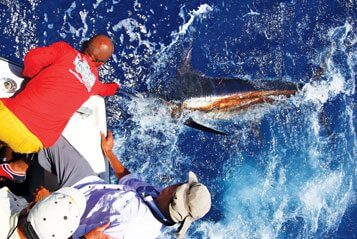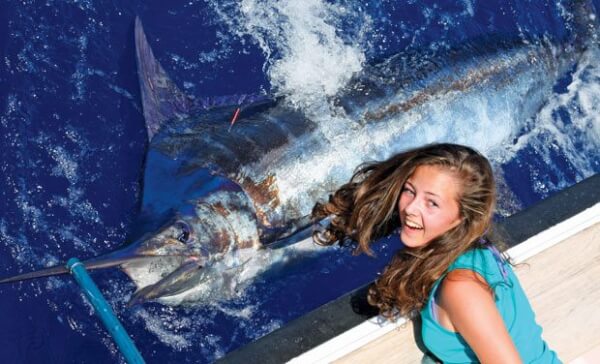Old-time black-and-white photos framed on the walls of fishing clubs throughout the Caribbean show anglers grinning broadly next to a huge dead marlin hung by its tail at a weigh-station. Today, this is a rare sight with catch and release. Instead of boating big fish, sports fishing in the Caribbean and many other places in the world is now a game of numbers rather than weight.
In other words, it’s how many billfish – blue marlin, white marlin and sailfish, for example – anglers can catch and release that determines their success during a fun day of fishing, or in a tournament, rather than who can boat the biggest fish.
Has the advent of catch and release over two decades ago helped to shore up billfish stocks in the Caribbean? “Yes,” answers Peter Chaibongsai, director of science and policy for the Ft. Lauderdale, Florida-headquartered The Billfish Foundation (TBF), “however, we have no hard data to show that the numbers are indeed up. There’s a lot of interest in the Caribbean, but it’s hard to get data. That’s because the region is made up of several nations all with different laws, management schemes and infrastructure.”
In spite of this great diversity, there has been a collective effort within the Caribbean’s sports fishing community to implement catch-and-release.
In the Turks and Caicos, Capt. Delphine Hartshorn of Panoply Sport Fishing & Charters, based at Turtle Cove Marina, explains, “We are very proud that our Caicos Classic IGFA Billfish Release Tournament, now in its 18th year, is a no kill tournament and has been for many years. Both Turtle Cove Marina and Blue Haven Marina advocate billfish release and all charter sport fishers follow suit. As a result, we enjoy a very productive blue marlin season in the summer months. It is not unlikely to hook up several blues in one day and to see more coming up on the spread as evidenced by Spellbound’s performance in this year’s Caicos Classic where they hooked up to four blues and saw three or four more hitting teasers in the final day of the tournament.”
The future of sports fishing in Puerto Rico and the Caribbean looks very good
Even more beneficial, many sports fishermen in the Caribbean, in tournaments and on charters, tag-and-release billfish. The placement of a small tag on the fish’s back just before release allows scientists to gain a huge amount of data such as migratory patterns and survival rates through re-catches. The Billfish Foundation’s Tag and Release Program is the largest private billfish tagging database in the world. Since its inception in 1990 through 2013, TBF has collected over 210,000 tag and release records from anglers. In 2013, TBF named Mike Brauser, from Lighthouse Point, Florida, owner of the 87ft Spencer, Betsy, the Top Tagging Angler for the Atlantic Ocean for Blue Marlin. Nearly all of Brauser’s over 100 tag-and-releases were done in waters off the Dominican Republic and Virgin Islands.
Captain Gary Clifford, who runs the 31ft Innovator, Yes Aye, out of True Blue Sportfishing Charters in St. George’s, Grenada, has contributed his fair share of billfish tags. “In the 16 years of fishing in Grenada I have used TBF tags in over 400 billfish, plus I have used National Marine Fisheries Service (NMFS) tags in quite a few and of course released many billfish without tagging (intentionally or otherwise!). So realistically I may have released 600 billfish. One sailfish I tagged here was caught again five months later in Key West, Florida.”
Over this same time period Clifford says he has noticed a decline in sailfish numbers. “Fifteen years ago we could raise 20 or more sails in the winter season. That very rarely happens now. On the other side of the coin, blue marlin numbers actually increased quite significantly during this period. Tag and release must have helped to some degree but for the most part our efforts are overwhelmed by the by-catch from artisanal long lining. Billfish are a highly migratory population so we should not just consider the impact of efforts in any one location but rather the regional or perhaps even global effect.”
Mike Fuller, who has fished off his home island of St. Croix, in the U.S. Virgin Islands, as well as throughout the Caribbean, makes note of another oft-used billfish conservation technique. “Probably the most significant thing has been the worldwide use of circle hooks for all billfish.”

A study conducted in 2002 by Dr. Eric Prince at the Miami, Florida-headquartered NMFS showed that sailfish caught on traditional J hooks were 21 times more likely to suffer hook-related bleeding and potentially fatal injuries than those caught-and-released on circle hooks.
Today, Caribbean sports fishermen not only practice, but are at the forefront of billfish conservation. For example, Club Nautico de San Juan’s International Billfish Tournament has introduced high-tech Pop Off Archival Tags. One of these tags, placed in a 575lb blue marlin on September 7 2011, popped off and surfaced off the coast of Angola on January 5 2012. In 2012, the IBT partnered with the National Geographic Society to deploy the scientist’s Crittercam system using the tournament’s participating boats in order to take pictures of blue marlin in their natural environment.
“The future of sports fishing in Puerto Rico and the Caribbean looks very good,” says Capt. Juan Carlos Torruella, who operates Extreme Fishing Puerto Rico. “With more and more people practicing catch-and-release and other conservation techniques I think our marlin population might stand a chance after all.”
TBF has recently revamped its website and made it easier for sports fishermen to share their catch, tag and release data with scientists. For more information, visit: www.billfish.org





